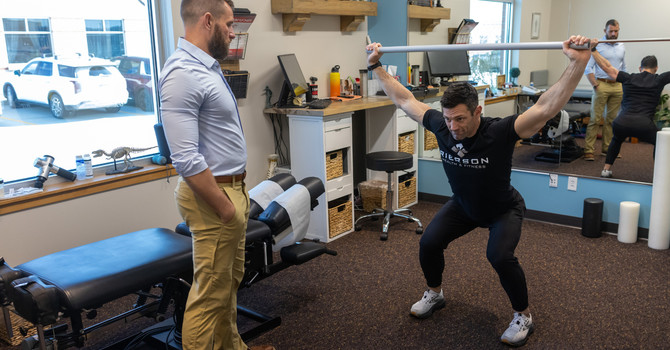
Heart Disease – The Silent Epidemic
February is Heart Healthy Month, a time to reflect on the steps we can take to protect our cardiovascular health. Despite advancements in medical care, cardiovascular disease (CVD) remains the leading cause of death in the United States. Often called the “silent killer,” heart disease disproportionately affects women, frequently showing no obvious symptoms until a serious event—like a heart attack or stroke—occurs.
Surprisingly, many people who suffer a cardiac event have had normal blood pressure and cholesterol levels their entire life. So, what’s going wrong?
The answer may lie in lifestyle factors we don’t always associate with heart health—like skeletal muscle mass. With sedentary desk jobs, busy schedules filled with family obligations, and poor dietary habits, many adults unknowingly set the stage for metabolic dysfunction, inflammation, and muscle loss, all of which significantly impact heart health.
As we age, maintaining adequate skeletal muscle mass for our age and gender is one of the most important things we can do to protect our heart.
Why Skeletal Muscle Mass Is a Game-Changer for Heart Health
Most people think of muscle as something that’s just for athletes or bodybuilders, but it plays a critical role in cardiovascular health. Here’s why:
1. Muscle Mass Supports Blood Sugar Regulation
Your skeletal muscle acts as a metabolic powerhouse, helping regulate blood sugar. Muscle tissue stores and utilizes glucose efficiently, reducing insulin resistance, which is a major risk factor for heart disease. Low muscle mass is often correlated with poor blood sugar control, increasing the risk of diabetes and metabolic syndrome, both of which double your risk of cardiovascular disease.
2. Muscle Reduces Inflammation – A Key Driver of Heart Disease
Chronic inflammation is a major contributor to heart disease, and low muscle mass is linked to higher levels of inflammatory markers. Strength training and maintaining lean body mass can help lower inflammation, improving heart function and overall health.
3. Stronger Muscles, Stronger Heart
The heart itself is a muscle. Engaging in resistance training and functional movement strengthens both skeletal muscles and the heart, making it more efficient at pumping blood and improving circulation.
4. Muscle Mass Helps Control Body Fat and Blood Pressure
A sedentary lifestyle and loss of muscle mass lead to higher fat accumulation, particularly around the abdomen. This visceral fat is dangerous because it increases blood pressure, promotes arterial plaque buildup, and raises the risk of stroke and heart attacks.
The Top 5 Ways to Improve Your Heart Health and Longevity
If you want to reduce your risk of heart disease, start by focusing on building and maintaining skeletal muscle mass while optimizing your overall lifestyle. Here are five science-backed strategies to support both muscle retention and heart health.
1. Optimize Protein Intake
Why It Matters: Protein is essential for muscle growth, repair, and retention, especially as we age. Research shows that adequate protein intake helps maintain lean body mass, which is crucial for heart health.
How Much You Need:
- Aim for 0.6–1.0 grams of protein per pound of body weight depending on activity level. Typically we see women do great with 75-90 grams/day and men have 90-115grams/day
- Prioritize high-quality sources like lean meats, fish, eggs, dairy, legumes, and plant-based proteins.
2. Prioritize a High-Fiber Diet
Why It Matters: Fiber is critical for gut health, cholesterol balance, and blood sugar regulation—all of which impact heart health. Soluble fiber found in foods like oats, flaxseeds, beans, and vegetables helps lower LDL cholesterol (the “bad” cholesterol) and reduces the risk of arterial plaque buildup.
Tips for Increasing Fiber Intake:
- Aim for 25–35 grams of fiber per day
- Eat whole, unprocessed foods rather than refined carbs
- Include fiber-rich foods like berries, chia seeds, avocados, and leafy greens
3. Stay Hydrated—With Electrolytes
Why It Matters: Hydration plays a direct role in maintaining healthy blood pressure, heart rhythm, and circulation. However, many people drink plenty of water but lack essential electrolytes like sodium, potassium, and magnesium, which are necessary for heart muscle contractions and blood pressure regulation
What to Do:
- Drink electrolyte-rich beverages (coconut water, electrolyte powders, mineral water)
- Eat potassium-rich foods like bananas, avocados, and sweet potatoes
- Avoid excessive caffeine and alcohol, which deplete hydration levels
4. Make Movement a Non-Negotiable Habit
Why It Matters: Both resistance training and cardiovascular exercise are essential for heart health. While aerobic exercise (walking, running, cycling) strengthens the heart, resistance training builds and preserves skeletal muscle, which is key for long-term cardiovascular protection.
How to Get Started:
- Aim for 150 minutes of moderate aerobic activity per week (brisk walking, swimming, biking)
- Include strength training 2–3 times per week (weights, bodyweight exercises, resistance bands)
- Avoid prolonged sitting—get up and move every 30–60 minutes. Consider a timer on your desk or watch to help remind you.
5. Improve Sleep Quality
Why It Matters: Sleep is one of the most overlooked factors in heart health. Chronic poor sleep increases inflammation, insulin resistance, and stress hormones, all of which negatively impact cardiovascular function.
Sleep Optimization Tips:
- Aim for 7–9 hours of sleep per night
- Reduce blue light exposure before bed (limit screens at night)
- Maintain a consistent sleep schedule (wake up and go to bed at the same time daily)
- Consider a Garmin Wearable to track sleep quality and chase and track your sleep goals
Taking Charge of Your Heart Health for the Long Run
The best way to protect your heart isn’t just about lowering cholesterol or watching your blood pressure—it’s about adopting a proactive lifestyle that supports muscle mass, metabolism, and inflammation control.
If you find yourself stuck in a sedentary routine, overwhelmed with daily responsibilities, or lacking motivation after years of neglecting self-care, now is the time to schedule fitness and recovery on your calendar.
Small, sustainable changes add up over time—and the sooner you start prioritizing muscle health and movement, the better your heart will thank you.
Final Thoughts: A Stronger Heart for a Longer Life
By focusing on building and maintaining skeletal muscle, optimizing nutrition, hydration, movement, and sleep, you can take powerful steps toward a healthier heart and a longer life.
Your heart health journey starts today—what’s the first step you’ll take?
FAQs
1. Can strength training really improve heart health?
Yes! Strength training helps reduce body fat, lowers blood pressure, and improves insulin sensitivity, all of which contribute to better cardiovascular health.
2. How does protein intake affect heart disease risk?
Adequate protein helps maintain muscle mass and metabolic function, which can prevent obesity, diabetes, and inflammation—all risk factors for heart disease.
3. What’s the best type of exercise for heart health?
A combination of aerobic exercise (cardio) and resistance training is ideal for strengthening both the heart and skeletal muscles.
4. Can dehydration increase heart disease risk?
Yes, dehydration can contribute to high blood pressure, poor circulation, and electrolyte imbalances, all of which can negatively impact heart health.
5. How does sleep affect cardiovascular disease?
Chronic sleep deprivation increases inflammation, stress hormones, and insulin resistance, all of which raise heart disease risk.



